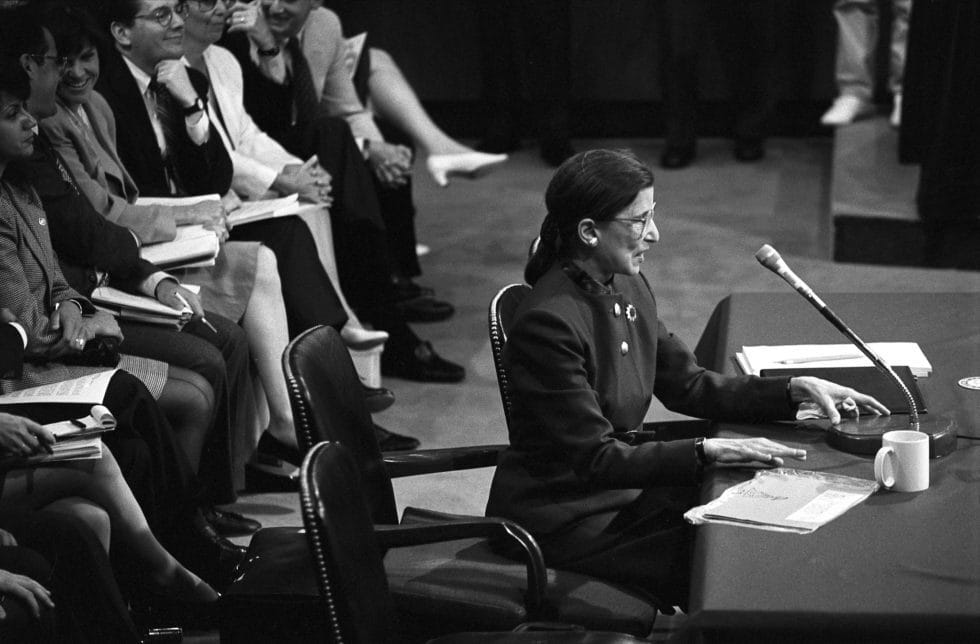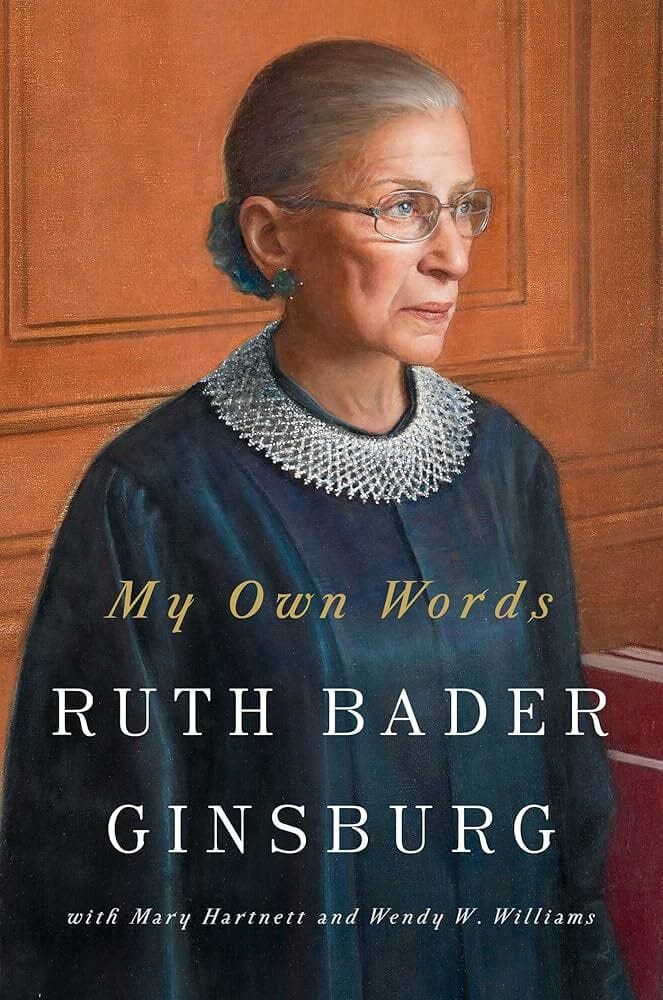- The Weekly Mensch
- Posts
- The Weekly Mensch: Ruth Bader Ginsburg
The Weekly Mensch: Ruth Bader Ginsburg
A courageous and unorthodox life of impact, justice, and excellence, grounded in passion, identity, and love
Us in a Nutshell
We are passionate about the lives, the impact, and the experience of Jewish baby boomers who have changed our world. From finance to the arts, we write about the stories of contemporary heroes who — significantly and meaningfully — changed the face of their respective industries, often starting with nothing but a legacy of exile. We tell their stories for the timeless lessons of intelligence, ethics, and resilience they underline. And we also share some fun anecdotes! Nathan Tob is a fourth-year student at the Queen Mary University of London. He studies Economics, Finance, and Management. Davy Sokolski is a third-year student at Columbia University in New York. He studies International Political Economy.
What is a Mensch?
Leo Rosten defines mensch as “someone to admire and emulate, someone of noble character.” Dr. Saul Levine writes in Psychology Today that a mensch’s personality characteristics include decency, wisdom, kindness, honesty, trustworthiness, respect, benevolence, compassion, and altruism.
Ruth’s Rapid Bio

Credit: People’s Parity Project
Ruth Bader Ginsburg was born on March 15, 1933, in Brooklyn to Nathan and Celia Bader, Jewish immigrants of Polish and Austrian descent. Growing up in a modest household, Ruth’s mother, Celia, was a significant influence, teaching her the value of independence, education, and perseverance. Although Celia passed away the day before her high school graduation, her guidance remained central to Ruth’s life career.
Ginsburg graduated at the top of her class from Cornell in 1954, where she studied government and met her husband, Martin Ginsburg, a future tax attorney and lifelong champion of her career. After starting a family, she attended Harvard Law School, balancing rigorous coursework, caring for her daughter, and supporting Martin through his cancer treatment. She later transferred to Columbia Law School, graduating first in her class in 1959. Despite her academic achievements, she faced gender discrimination when seeking legal employment.
Ruth began her career as a professor at Rutgers Law School and later became the first woman to achieve tenure at Columbia Law School. In the 1970s, as director of the ACLU Women’s Rights Project, she argued six landmark gender discrimination cases before the US Supreme Court, winning five. Her strategic approach focused on showing how gender inequality harmed both men and women, building a legal framework for greater equality under the law.
In 1993, President Bill Clinton nominated Ginsburg to the US Supreme Court, making her the second woman and the first Jewish woman to serve on the Court. During her tenure, she authored landmark decisions, including United States V Virginia (1996), which struck down the Virginia Military Institute’s male-only admissions policy. She penned notable conflicts on voting rights, pay equity, and healthcare, earning her the nickname “The Notorious RBG”. Her dissents became rallying cries for progress and inspired a generation to advocate for justice.
Ruth’s Jewish heritage deeply informed her commitment to justice and equality. She credited the Jewish principle of Tzedek, Tzedek Tirdof (Justice, justice shall you pursue) as a guiding force throughout her life. Beyond the bench, she was a devoted wife, mother, and grandmother.
Ruth Bader Ginsburg passed away at 87, on the eve of Rosh Hashana, a moment often associated with the passing of a righteous person, or tzaddik. She left a legacy as a brilliant legal mind, a trailblazer for women’s rights, and an enduring icon of resilience, equality, and justice.
Ruth’s Five Lessons
1. Excellence is built into the details
Ruth Bader Ginsburg’s remarkable career wasn't shaped by dramatic gestures or sweeping change but by her unwavering attention to detail. From meticulously preparing for each case she argued to carefully wording her dissents, Ruth believed that the smallest tasks deserved her full dedication. One vivid instance was her work on United States v. Virginia (1996), a landmark case that challenged Virginia’s Military Institute’s male-only admissions policy. Before writing the majority opinion, RBG meticulously reviewed the history and the institution, the constitutional arguments, and the broader implications of gender discrimination. She approached the case with surgical precision, crafting an opinion that not only addressed the immediate issue but also set a transformative precedent for gender equality. Her ability to focus on fine points– whether drafting a legal document, balancing her family responsibilities, or recovering from illness –defined her success. She knew that excellence didn’t come from a single moment but from a disciplined, deliberate approach to everything she undertook. For Ginsburg, the details were not just steps along the way they were the building blocks of her enduring legacy.
Success isn't about grand moments but how we handle the day-to-day details with care and focus. By pouring effort into even the smallest tasks, we cultivate habits of excellence that prepare us for bigger opportunities. Ruth teaches us that in every aspect of life, it’s the commitment to doing even the smallest things with care and purpose that paves the way for lasting success.
2. The power of quiet leadership
Ruth exemplified the power of quiet leadership. She didn't seek the spotlight or lead with loud proclamations; instead, she built her influence through thoughtful action and meticulous work. Her legal arguments were legally constructed, her dissents precisely worded, and her decisions guided by clarity and fairness. A demonstration of her quiet leadership came during her time as a law professor at Rutgers. Faced with systemic pay discrimination, Ginsburg didn’t confront the institution publicly or aggressively demand change. Instead, she methodically gathered data, collaborating with other female faculty members to build a compelling case. She knew that lasting change came not from dramatic gestures but from steady, deliberate efforts to build consensus and inspire trust. Her calm demeanor and unwavering commitment earned her respect across the legal world and beyond, proving that leadership isn't about volume — it’s about impact.
Leadership doesn't always need to be loud to be effective. True influence is built through consistency, integrity, and focus on long-term goals. Whether in the workplace, relationships, or personal endeavors, quiet leadership reminds us that thoughtful actions speak louder than grand statements, and meaningful change often starts with a measured, deliberate approach.
3. Lift others as you rise
Ruth believed in using her success to create opportunities for others. Throughout her career, she mentored countless young lawyers who often faced the same barriers she had encountered. One impactful example was RBG’s mentorship of Justice Elena Kagan. Before her nomination to the Supreme Court Ruth worked closely and inspired Kagan, with Kagan often crediting Ginsburg’s influence and example as pivotal to shaping her own approach to law and leadership. At Rutgers and Columbia, she taught and inspired future generations of legal minds, sharing not only her knowledge but her determination to challenge inequality. As a Supreme Court Justice, she advocated for fairness and equality, setting a precedent that paved the way for others to follow. Ruth’s commitment to mentorship and inclusion wasn't just about helping individuals; it was about ensuring that progress continued long after her own achievements.
True success isn't measured solely by personal accomplishments but by the impact we have on others. By lifting others as we rise, we create a ripple effect that multiplies success and drives lasting change. Whether through mentorship, collaboration or simply opening doors to others, we ensure that progress becomes a shared journey, not a solitary climb.
4. Work keeps alive
“As long as I’m healthy and my brain is sane, I will keep doing what I do.” This quote from Ginsburg who served on the Supreme Court until she died in 2020, when she was 87, is a testimony of her passion for her work. But not only was she passionate about her legal activity, this was the reason for her life, what kept her alive. Through sickness, family hardships, and losing her husband, Ginsburg found solace in her work. She needed to engage in work and only that deep connection with her work enabled her to achieve great outcomes. For Ginsburg– as for many Mensches we present weekly –work was first and foremost energizing and fulfilling. Ruth Bader Ginsburg wasn’t a woman practicing law, she was a justice. Her work was very strongly tied to her identity, the way she thought of herself internally, and the way she presented herself to others. There was no division between her life and her activity, her life was all about her activity. She dedicated her entire person to the principles she defended and embodied the values she carried through her work.
Through tying her identity to her work, she made her life and principles revolve around her mission as a justice. She teaches that great work cannot be separated from everything else in one’s life. Making your life all about your mission and principles is the only way to do great work and live a life that impacts the doers and drives positive externalities on all others.
5. Marry your biggest booster
In an interview she gave to David Rubenstein, RBG says she married her booster. She talks about her marriage with Martin D. Ginsburg and how it wasn’t only about love but also about a true understanding of common aspirations in life: “he was the first man who cared I had a brain.” Ginsburg recounts her marriage as a common enterprise grounded in values and genuine support. Both Ruth and David had bold ambitions, immense talent for the work of law, and a genuine desire to build a Jewish family and excel in all they do at the same time. Ruth comically shares that her husband was the one taking care of the children and the cooking at home, marking yet again the very nonconformist nature of the couple and the entire family in the 1960s. For Ruth, her husband was a team member in accomplishing her objectives, and vice versa. None of them was navigating their path to success alone, they could rise and take risks with the assurance of a solid support they built together. In a very distinguished yet funny way, Ruth recounts that the day she got married, her mother-in-law told her the secret to a successful marriage was “to be a little deaf every now and then.”
Ruth and Martin’s couple showed how the power of being together through thick and thin makes all the difference. RBG says she married her “biggest booster in life,” and emphasizes that the unity, the support, and the horizontal relationship at the basis of her marriage was instrumental in her success. The romantic (but not only) journey of the Ginsburgs is a powerful reminder that true partnership in life and love is built on mutual respect, shared goals, and unwavering support. The outcome is for both individuals to reach their full potential and achieve greatness together.
The Quote of The Week
“Tzedek, Tzedek Tirdof. Justice, justice shall you pursue. Not because it is easy, but because it is right.”

Reply